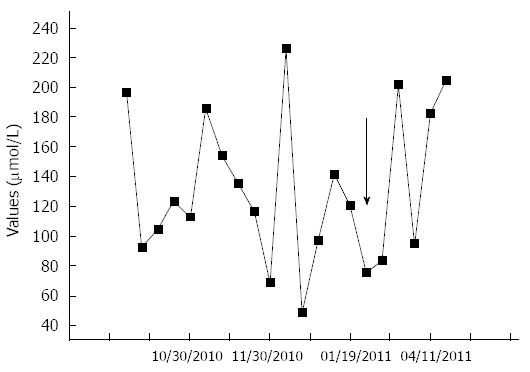Copyright
©2014 Baishideng Publishing Group Inc.
World J Gastroenterol. Nov 14, 2014; 20(42): 15910-15915
Published online Nov 14, 2014. doi: 10.3748/wjg.v20.i42.15910
Published online Nov 14, 2014. doi: 10.3748/wjg.v20.i42.15910
Figure 1 Venographic images of the splenorenal shunt before the embolization, showing a narrowing point where the 8 microcoils would be placed.
Inferior vena cava (white arrow); left renal vein (white arrowhead); splenorenal shunt with the catheter inside it (black arrow); narrowing location inside the splenorenal shunt (black arrowhead).
Figure 2 Angiographic images of the splenic vein after the shunt embolization, showing the 8 microcoils placed in the splenorenal shunt.
Splenic vein (black arrow); microcoils (black arrowhead). The catheter is inside the splenic artery, and the image is obtained in a late phase after the contrast injection. The metallic tip of the nasoenteral tube can also be seen in the right upper quadrant.
Figure 3 Ammonia values and their respective dates obtained from venous samples before and after the shunt embolization (arrow), showing that there were no major differences between the values before and after the procedure, due to the other shunts that the patient already had before the embolization.
The black arrow indicates the date of the splenorenal shunt embolization.
- Citation: Franzoni LC, Carvalho FC, Garzon RGA, Yamashiro FDS, Augusti L, Santos LAA, Dorna MS, Baima JP, Lima TB, Caramori CA, Silva GF, Romeiro FG. Embolization of splenorenal shunt associated to portal vein thrombosis and hepatic encephalopathy. World J Gastroenterol 2014; 20(42): 15910-15915
- URL: https://www.wjgnet.com/1007-9327/full/v20/i42/15910.htm
- DOI: https://dx.doi.org/10.3748/wjg.v20.i42.15910











